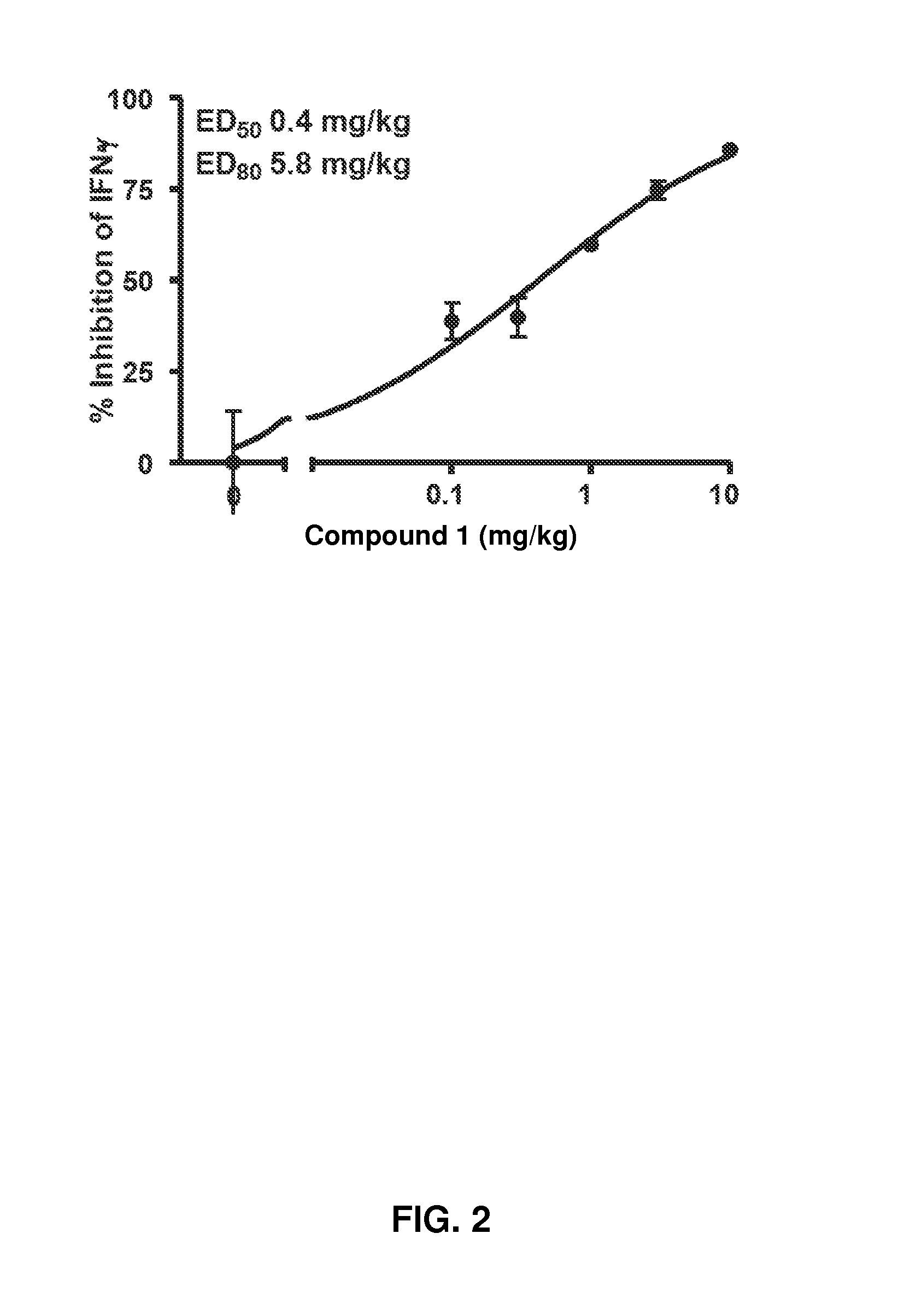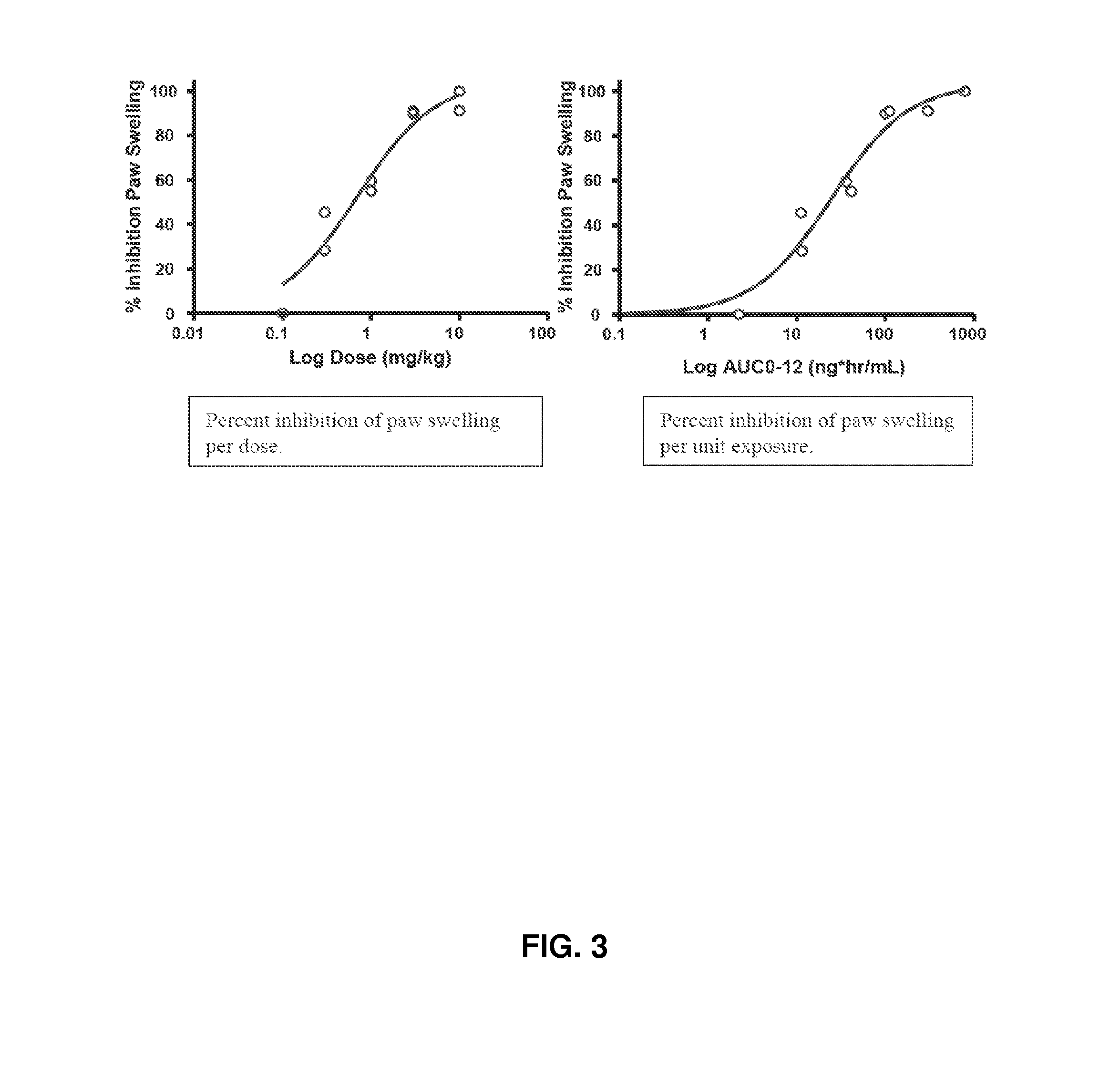Jak1 selective inhibitor and uses thereof
a selective inhibitor and inhibitor technology, applied in the field of jak1 selective inhibitors, can solve the problems of low jak1 selectivity, low potency, and many ra patients that fail to experience substantial decreases in disease activity, and achieve modest but significant improvement of jak1/jak2.
- Summary
- Abstract
- Description
- Claims
- Application Information
AI Technical Summary
Benefits of technology
Problems solved by technology
Method used
Image
Examples
example 1
Potency of Compound 1 Against Jak Kinases and Related Kinases
[0342]The potency of Compound 1 on recombinant Jak family kinase domains was determined using in vitro reactions using adenosine-5′-triphosphate (ATP) as a competitive inhibitor.
[0343]The results indicated that Compound 1 is an ATP competitive inhibitor, and is most potent against Jak1 with concentration at 50% inhibition (IC50) of about 0.045 μM when tested at 0.1 mM ATP (FIG. 1) and <0.003 μM at 0.001 mM ATP (data not shown).
[0344]Compound 1 displays good selectivity in a panel of 60+ protein kinases that also includes Jak3 (data not shown). Of the kinases in the panel, 14 kinases have an Compound 1 IC50 below 10 μM, but only 2 non-Jak kinases have IC50's below 1 μM (Rock1 at 0.55 μM and Rock2 at 0.43 μM).
example 2
Potency of Compound 1 in Cellular and Other Assays
[0345]Interleukin-2 (IL-2) is believed to signal via a receptor complex that requires the kinase activity of both Jak1 and Jak3. To evaluate the effects of Compound 1 on Jak1 / Jak3 inhibition in a cellular context, inhibition of IL-2-induced phosphorylation of STAT5 in human T-blasts by Compound 1 was assessed by AlphaScreen SureFire readout (STAT5 p-Tyr694 / 699). The IC50 for Compound 1 was 21±4 nM (Table 1).
[0346]Interleukin-6 (IL-6) is believed to signal via a gp130 / IL-6Rα receptor complex that requires the kinase activity of 2 Jak1 molecules. To evaluate the effects of Compound 1 on Jak1 inhibition in a cellular context, inhibition of IL-6-induced phosphorylation of STAT3 in human erythroleukemia TF-1 cells by Compound 1 was assessed by AlphaScreen SureFire readout (STAT3 p-Tyr705). The IC50 for Compound 1 was 9±5 nM (Table 1).
[0347]Erythropoeitin (EPO) is believed to signal via a receptor complex that requires the kinase activity ...
example 3
In vivo Potency as Measured by Animal Models
[0355]Jak1 in vivo potency was measured in acute (concanavalin A induced interferon [IFN]γ) and chronic (adjuvant-induced arthritis) rat models.
[0356]The rat concanavalin A (Con A) model was selected as the acute screening model because it provides an assessment of oral bioavailability, as well as a rapid measurement of effects on Jak1-dependent mechanisms. Intravenous injection of Con A into Lewis rats results in T cell receptor ligation and activation, leading to IL-2 release and IFN-γ induction by an autocrine mechanism. IL-2 release is Jak-independent, whereas IFN-γ induction is blocked by Jak1 inhibitors.
[0357]Rats are dosed orally 30 minutes prior to intravenous Con A to coincide with the oral time to maximum observed plasma concentration (Tmax) for the majority of these inhibitors. Plasma levels of IFN-γ and IL-2 are assessed 4 hours later in a terminal bleed.
[0358]When Compound 1 was dosed orally as described above at 10, 3, 1.0, 0...
PUM
| Property | Measurement | Unit |
|---|---|---|
| pH | aaaaa | aaaaa |
| pH | aaaaa | aaaaa |
| temperature | aaaaa | aaaaa |
Abstract
Description
Claims
Application Information
 Login to View More
Login to View More - R&D
- Intellectual Property
- Life Sciences
- Materials
- Tech Scout
- Unparalleled Data Quality
- Higher Quality Content
- 60% Fewer Hallucinations
Browse by: Latest US Patents, China's latest patents, Technical Efficacy Thesaurus, Application Domain, Technology Topic, Popular Technical Reports.
© 2025 PatSnap. All rights reserved.Legal|Privacy policy|Modern Slavery Act Transparency Statement|Sitemap|About US| Contact US: help@patsnap.com



